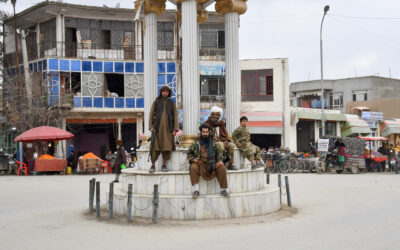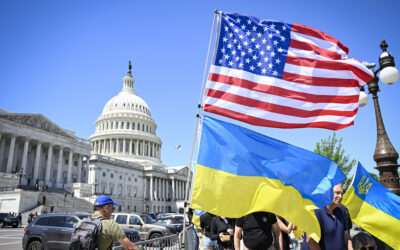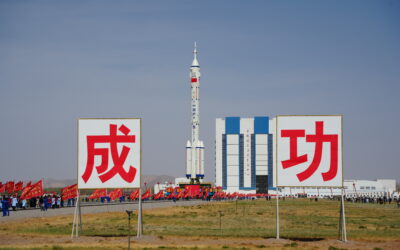
The Long Arm of China’s Security Services
SUBSCRIBER+ EXCLUSIVE REPORTING — When Chinese President Xi Jinping came to San Francisco last November to meet with President Joe Biden, Chinese pro-democracy activists in […] More
OPINION — There ought to be more public discussion over the following quote from the Biden Nuclear Posture Review (NPR) that was released November 8:
“By the 2030s, the United States will, for the first time in its history, face two major nuclear powers [Russia and China] as strategic competitors and potential adversaries. This will create new stresses on stability and new challenges for deterrence, assurance, arms control, and risk reduction.”
One day after that NPR came out, a Heritage Foundation panel entitled What China’s Strategic Breakout Means for the U.S., saw two respected, nuclear weapons experts agree that under these new circumstances, the U.S will need more deployed strategic and non-strategic nuclear warheads.
For years, China maintained only 65 strategic nuclear intercontinental ballistic missiles (ICBMs) for minimum deterrence and announced its policy would be no first use of a nuclear weapon. However, because China has begun creating three fields for new silo-based ICBMs, the prospect is that by the 2030s, they could have 1,000 warheads, or even more.
At the Heritage meeting, Franklin Miller, who served 22 years in senior Department of Defense positions and was Senior Director for Defense Policy and Arms Control on President George W. Bush’s National Security Council staff, said China’s apparent nuclear buildup “was well beyond what is necessary to deter the United States, Russia, and even India…We’re no longer looking at a force designed to back up a strategy of no first use and minimum deterrent. The big question is, what is the aim of this Chinese nuclear buildup at all levels, medium-range, short-range and intercontinental-range?”
Pause for a moment and realize that Miller is saying that China, facing three nuclear-armed countries, not just two, will have more than enough if it goes for 1,000 or perhaps more nuclear warheads.
Moments later, Miller said, referring to the U.S., “In my judgment, the 1,550 [permitted strategic warheads] of New START [the 2010 treaty between the U.S. and Russia] will not be sufficient in a couple of years.”
Now with the Scowcroft Group, Miller added that 1,550 is “barely sufficient now [and] not sufficient for 2024-2025.”
Also participating at the Heritage Foundation was Dr. Brad Roberts, director of Lawrence Livermore National Laboratory’s Center for Global Security Research. He said a new problem created by China’s nuclear buildup for the U.S. was “the need to deter simultaneously in two regions [Europe and Asia], and to respond in one or two at the same time.”
A former Deputy Assistant Secretary of Defense for Nuclear and Missile Defense Policy during the Obama administration, Roberts added, “1,550 [warheads] was sufficient for the security environment we were in for that time…[but] circumstances have changed quite a lot. It can’t be the right number. Fewer is certainly not the right number in these circumstances. So more…though it need not be a one-for-one mix – they have 360 new [warheads], we should have 360 new. It’s not that simple.”
Get your 10-minute daily national security brief with Suzanne Kelly and Brad Christian by signing up for The Cipher Brief’s Open Source Report Daily Newsletter or by listening to The Cipher Brief’s Open Source Report Podcast wherever you listen to podcasts.
While talking numbers, it is worth noting that if the New START limits were dropped, the U.S. could add hundreds of new warheads from its non-deployed nuclear stockpile within days, weeks, or months, depending on the type of launcher.
For example, there are 200 deployed Minuteman III ICBMs, which today carry only a single warhead, but are capable of carrying two more warheads. They could be uploaded, plus the U.S. has 50 empty ICBM silos which could be reloaded with missiles carrying three warheads, if necessary.
Within months, the U.S. could add 550 additional deployed warheads just to its land-based ICBM force. Another 1,000 nuclear warheads could be uploaded on deployed submarine-launched Trident D-5 intercontinental missiles, which, to meet the New START limits, today carry fewer warheads than capacity.
Back at the Heritage panel, Roberts raised another issue. “For the projected [Chinese plus Russian warheads], while it’s important to get the numbers right, but [we should] not…focus solely on the numbers,” he said. “The emergence of a second nuclear peer is going to have far-reaching consequences. Some are simply additive…but some are transformative.”
In the latter category, he named, “the implication for our nuclear [weapons] employment [use] policy. Are we going to do two [China and Russia] at the same time in our employment policy? Are we going to do one [country] after the other? Is one simply less or included?”
Roberts then said, “This will invite again the long-standing debate about: Is counterforce stabilizing or destabilizing and helpful or unhelpful to our deterrence and employment strategies.”
Counterforce, as used within the nuclear weapons community, refers to using your nuclear weapons to attack the enemy or enemies’ nuclear weapons as well as command and control facilities.
This idea tracks back to former U.S. Defense Secretary Robert McNamara who disliked the idea that nuclear weapons would be used to wipe out cities and decided they should be used against the Soviet Union’s ICBMs. While it seemed less objectionable, it also required more strategic warheads since there were more Soviet missiles to target than there were Russian cities worth hitting.
Subscriber+Members have a higher level of access to Cipher Brief Expert Perspectives on Global Issues. Upgrading to Subscriber+ Status now.
I have reported what Miller and Roberts said because they illustrate internal discussions that nuclear weapons strategists, who have formed a sort of priesthood, have had among themselves for years that don’t involve what horrendous short-term and long-term damage even one of these nuclear weapons of today could do.
Remember, two atomic bombs ended a war: One exploded over Hiroshima with 12.5 kilotons (the equivalent of 12.5 thousand tons of TNT) of explosive power and the other, three days later, over Nagasaki at 23 kilotons. They were both detonated more than 1,200-feet above ground so that the fireballs created did not hit the ground so there was minimal radioactive fallout and only directly below the explosions.
While there were 135,000 killed or wounded at Hiroshima and another 64,000 at Nagasaki, the two cities were rebuilt and exist today.
However, most of today’s nuclear weapons have higher yields and with targets on the ground and perhaps below ground, there would be radioactive fallout not just in the vicinity of the immediate targets, but for miles around depending on how the wind was blowing.
When considering nuclear weapons use, do not think Hiroshima/Nagasaki; think Chernobyl where a 1986 nuclear reactor explosion, the estimated equivalent of one, low-yield tactical nuclear weapon, caused serious fallout in a 1,000-square-mile area where people are still excluded from living.
Part of the irony associated with nuclear weapon discussions is that while they were not invented to be war-fighting weapons, thousands of them exist, but at the same time, their main value is in deterring their use by an enemy.
The danger of this new situation, the U.S. facing the threat of two peer nuclear nations rather than one, is that it provides a rationale for building even more numbers or types of nuclear weapons.
The Wall Street Journal published an editorial pointing out that the Biden NPR cancels a new nuclear submarine-launched cruise missile (SLCM-N) and arguing that Congress has legislation to keep it funded. The Journal argued that Putin has “up to 2,000 such tactical nukes” and that although SLCM-N would be “only one small part of the [U.S.] nuclear arsenal…No president should have to choose between doing nothing or nuking Moscow.”
Of course, that is never going to be the choice, although it often is the argument for whatever new nuclear weapon someone wants to build.
Roberts at Heritage made an important suggestion on the so-called U.S. “extended deterrence” policy which implies retaliation by American forces if nuclear weapons are used against an ally. Initiated during the Cold War for NATO allies threatened by Soviet Union nuclear weapons, Roberts said, “Our allies in east Asia have consistently asked…why can’t they have more NATO-like extended deterrence”
He continued, “NATO allies have what east Asian allies have not – an agreed consultative process for nuclear employment decision-making.” While the American President has the sole authority to order or not order the use of nuclear weapons, Roberts said, “In Europe, our allies wanted a seat at the table, got a seat at the table and it was in our interests to have them at the table because if we ever have to make that action on their behalf, we want them to share that responsibility.”
He added, “Our allies in east Asia don’t have a table; we don’t have an agreed mechanism for this kind of consultation. It would be reassuring to them and think it would send a powerful deterrence message.”
The Biden NPR’s section on the Indo-Pacific region actually calls for “stronger extended deterrence consultation emphasizing a cooperative approach between the United States and Allies in decision-making related to nuclear deterrence policy, strategic messaging, and activities that reinforce collective regional security. Building on the extended deterrence dialogues established over the last decade with the Republic of Korea (ROK), Japan and Australia, and other forums, we will identify pragmatic steps to enhance consultation.”
Another interesting new idea in the Biden NPR recognizes that because of China’s nuclear program “a time might come for additional warheads.” But it adds, “Non-nuclear capabilities may be able to complement nuclear forces in strategic deterrence plans and operations in ways that are suited to their attributes and consistent with policy on how they are to be employed.”
This so-called “integrated deterrence,” would, according to the NPR, combine the Joint Force “nuclear and non-nuclear capabilities…in complementary ways that leverage the unique attributes of a multi-domain set of forces to enable a range of deterrence options backstopped by a credible nuclear deterrent.”
For example, the Biden NPR said: “When engaged in conventional operations against a nuclear-armed adversary, the Joint Force must be able to survive, maintain cohesion, and continue to operate in the face of limited nuclear attacks. This form of resilience sends a distinct deterrence message to an adversary – that limited nuclear escalation will not render U.S., Allied, and partner forces incapable of achieving our war-fighting aims.”
However, the NPR added, “Developing the needed operational and organizational concepts will take time and require additional research, evaluation, and experience.”
Meanwhile, I take some heart in a statement by Biden after his meeting with Chinese President Xi Jinping. “We discussed Russia’s aggression against Ukraine [and] reaffirmed our shared belief that the threat or the use of nuclear weapons is totally unacceptable,” Biden said.
Let’s hope everyone feels the same way.
Read more expert-driven national security insight, perspective and analysis in The Cipher Brief
Related Articles

SUBSCRIBER+ EXCLUSIVE REPORTING — When Chinese President Xi Jinping came to San Francisco last November to meet with President Joe Biden, Chinese pro-democracy activists in […] More

SUBSCRIBER+EXCLUSIVE EXPERT PERSPECTIVE — More than two years after its withdrawal from Afghanistan, the U.S. still does not have a clear way forward in the […] More

SUBSCRIBER+ EXCLUSIVE REPORTING — Ukrainians greeted Saturday’s long-awaited House passage of $60.8 billion in aid with justifiable jubilation. For months, their soldiers, civilians, and political […] More

SUBSCRIBER+ EXCLUSIVE REPORTING — A race for control of space is underway, and just as on earth, the U.S. and China are the top competitors. […] More

SUBSCRIBER+ EXCLUSIVE REPORTING — For nearly a week, the Middle East and much of the world were on a knife’s edge, waiting for a promised […] More

BOTTOM LINE UP FRONT – Less than one week after Iran’s attack against Israel, Israel struck Iran early on Friday, hitting a military air base […] More
Search